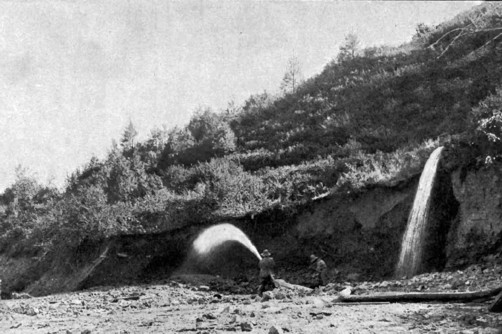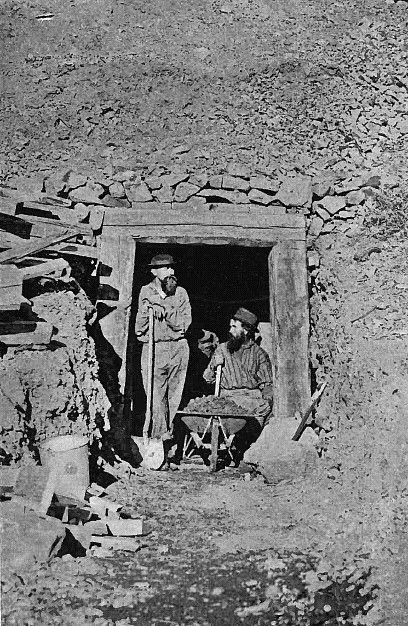Over the huge range of Blue mountains in Grant county are 4.200 square miles of mineral in ledge and placer—that is an area more than half as large as the state of Massachusetts. The placer gold nugget mines of the county have yielded over $5,000,000, and there are thousands of acres yet that have never felt the touch of pick or shovel. Quartz vein mining is in its babyhood, though great discoveries have been made and great mines opened. In the Granite district, about 20 miles northwest of McEwen. the Bellevue has exposed, by mere development work, 20,000 tons of $20 ore. and 20,000 more that will mill $14 to the ton. With the Crawford mill, the Red Boy has already paid for itself and a number of adjoining properties, built several miles of canal, and erected all its own buildings. Its gold ore runs from $14 to $20 to the ton, mostly free gold. Three miles southwest of the Bellevue mine. The Monumental is running a l0 stamp mill on high grade silver ore. while its next neighbor. the Buffalo, has taken out ore that yielded $400 to the ton in gold.
In the Olive Creek or Robinsonville district, the Bonanza mine, at a depth of 300 feet, has 300,000 tons of ore in sight that mills from $8 to $20 to the ton—an aggregate of over $3,000,000. It has a 20-stamp mill and a concentrating plant, its machinery is run by water power, and the total cost of mining and milling its ore is but $2 a ton. Some of its recent clean-ups have amounted to $1,000 a day. The capacity of its entire plant is to be doubled, as soon as the machinery can be brought in and set up. The Phoenix and the Pyx have each a 5-stamp mill, running on ore that averages $26 to the ton in the Phoenix, and ranges from $9 to $70 to the ton in the Pyx. The Worley and Virginia have good showings.
The Don Juan is a young wonder. With a little 3-stamp prospecting mill, it is taking out big money, its ore yielding $110 to the ton. Some of it, hand-picked, sacked and shipped for more perfect treatment, runs over $1,000 to the ton. The placers of this district have panned out hundreds of thousands in gold nuggets and are still steady producers. In the Quartzburg district, some astonishingly rich finds have been made. For about 100 feet down the ore is free milling; below that depth, solid sulfides. The Gifford, with an old-time waterpower arrastra, has produced gold enough to pay for itself and all development, and a good many thousands of profits. A recent run of 21 tons through the antique arastra cleaned up $2,740, or a little over $130 to the ton.
The Keystone, Colorado, Little Denver, Cougar, Alta, Midnight and Jackson-Dunn all show fine bodies of gold ore. Two small mills cannot begin to handle the ore that is offered for treatment, and the machinery for another 5 ton smelter has just been brought in. A 100 ton stamp mill would get all it could do. In the Susanville district, the placer mines, worked in primitive fashion, yield about $20,000 a year, and there is an immense territory still unexplored. Among the comparatively few quartz locations is the group of the Elk Creek Mining Company, including, with a half-dozen others, the Cabell, which has yielded from one little hole 70 feet deep $88,000 in gold bullion. On the Princess group, owned by an English company, a strike of ore has just been made, showing a mass of free native gold. The Gem, South Gem and Ironsides are all in rich ore.
More than $2,500,000 has been washed out of the placer beds of Canyon Creek and vicinity, all by the crudest, old timey processes. Millions of dollars are still lying in the gravel waiting for modern methods and machinery to turn them into the treasuries of the world. Canyon Mountain, the source of all this pan-and-rocker wealth, has never been prospected for the mighty lodes it undoubtedly contains. In the new Hot Springs district there are outcropping ledges of free-gold ore from 30 feet to 600 feet wide, miles of which have never been located or claimed. In the Fox district, the Butte mine has a vein 88 feet wide of free-milling gold ore that runs from $2.60 to $10.50 to the ton, and its entire plant is a little 5-stanip mill. In the southern end of Baker county and the northern end of Malheur, and away down on Trout creek in Harney, many rich prospects have recently been discovered; a vast dike of copper ore runs for miles through the Quartzburg region of Grant county and immense deposits of coal crop out on the headwaters of John Day river. Volumes might be filled with the mere roll-call of possibilities to be met everywhere in this Oregonian land of gold. There is no need of going out of this country to seek fortune. It is here for everyone who comes with his eyes open, and ready to take it!
Return
to The Oregon History Page:
Oregon Gold Rush History



